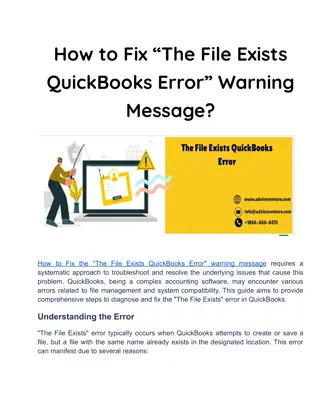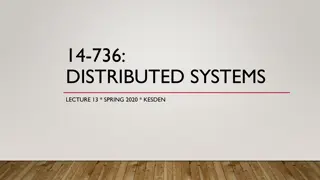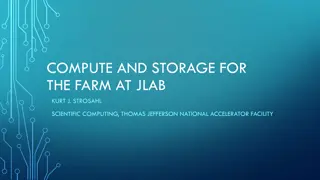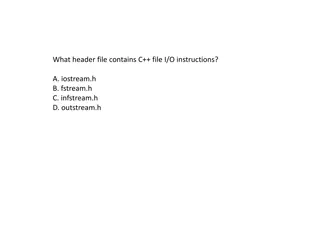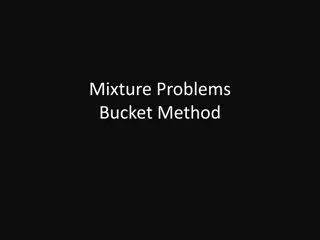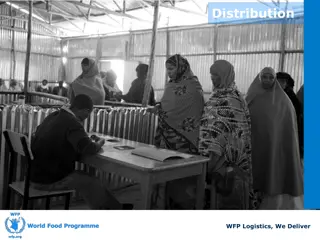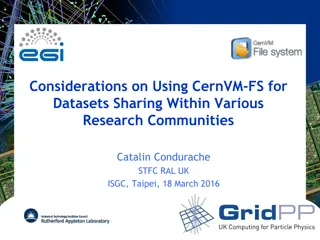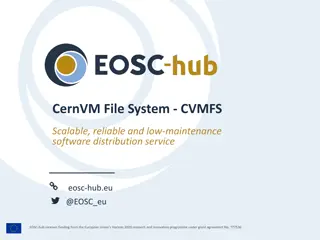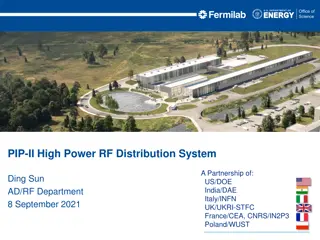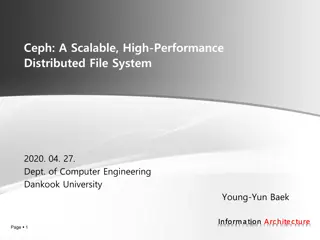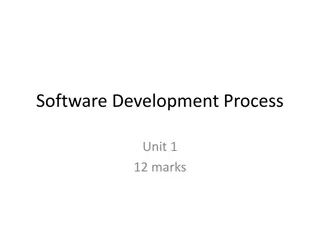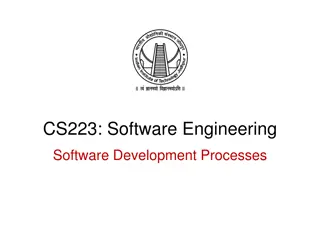Facilitating Software Distribution with CernVM File System and S3 Bucket
Facilitating the distribution of software by leveraging the CernVM File System and S3 bucket for effective sharing in a distributed environment. The INFN DataCloud project addresses the software distribution challenge through the Software Management @DataCloud solution, aiming to simplify adoption of technologies like CernVM FS. User-friendly approaches and automation enable seamless access to software repositories.
Download Presentation

Please find below an Image/Link to download the presentation.
The content on the website is provided AS IS for your information and personal use only. It may not be sold, licensed, or shared on other websites without obtaining consent from the author. Download presentation by click this link. If you encounter any issues during the download, it is possible that the publisher has removed the file from their server.
E N D
Presentation Transcript
Facilitating the distribution of software by using CernVM File System and S3 bucket Giada Malatesta giada.malatesta@cnaf.infn.it Francesca Del Corso francesca.delcorso@pg.infn.it Alessandro Costantini alessandro.costantini@cnaf.infn.it Daniele Spiga Daniele.Spiga@pg.infn.it Massimo Sgaravatto massimo.sgaravatto@pd.infn.it Sergio Traldi sergio.traldi@pd.infn.it Taipei, 28/03/2024 International Symposium on Grids and Cloud
Outline Context The INFN DataCloud project Software Management Service The software distribution challenge The Software Management @DataCloud solution Workflow overview Adopted technologies Implementation and user perspectives Conclusions Summary 2
Context 3
The INFN DataCloud project The DataCloud Project manages all core activities related to computing@INFN and its projects Development, implementation & management of the INFN Datalake architecture Development of ISO-Certified solutions mainly for clinical and omics data management Support to users and to the management and operation of all INFN sites (both Grid and Cloud paradigms) Development of new services Focus people, solutions. on resources, methods, Integration of Modular composition. architecture based on service The INFN foundation of all the NRRP computing- related initiatives. 4
User software distribution: the challenge In a distributed and heterogeneous environment the sharing of software, libraries and configurations in an effective, user-friendly and challenging. transparent way can be There are already low-level solutions that address this challenge. Our aim is to further simplify the adoption of a well established technologies such as Cern-VM File System (CVMFS) in a highly multidisciplinary environments. 6
Software Management @DataCloud: the strategy In order to cope with the challenge in a Cloud infrastructure, such as our DataCloud, we Management service. implemented a Software We build on top of a well established technology known as CernVM File System (CVMFS). Abstraction: what the project adds, is to avoid to know any technical details about CVMFS abstractions in order to let the user accessing the repository in a simple and completely transparent way. mechanisms providing Automation: in other words we enable the possibility to copy software, libraries and related configuration files etc in S3 cloud storage and that's it. dependencies, small files, 8
an open-source, software usable distribution and It s customizable service. It s a network file system implemented as a POSIX read-only file system. Files and directories are hosted on standard web servers and mounted in the universal namespace /cvmfs. It uses standard HTTP transport, avoiding most of the firewall issues. It is a read-only files system for those who access it, only the admin is able to modify its content. 9
Workflow overview The user requests a CVMFS repository (personal or group) via the INFN Cloud dashboard. The request is send to RabbitMQ and is elaborated in order to create the repository. Once created, the relative keys are published in a Vault system. The user accesses the S3 object storage space and creates a bucket (personal or group). He uploads what he want to distribute in a specific area of the bucket named cvmfs. The S3 bucket service system sends a message to RabbitMQ so that the system get notified and can synchronize the content of the correspondent CVMFS repository. At this point, the user can access the CVMFS client in read mode to the distributed software. The user can populate his repository by installing a CVMFS publisher by using his repository keys. 11
Adopted technologies The CernVM File System provides a scalable, reliable and low- maintenance software distribution service. CernVM-FS is implemented as a POSIX read-only file system in user space (a FUSE module). Files and directories are hosted on standard web servers and mounted in the universal namespace /cvmfs. Ceph is an open-source, distributed storage system. Vault automatically authenticate and authorize access to secrets and other sensitive data. provides organizations with identity-based security to RabbitMQ provides an open-source, reliable, scalable platform for message delivery, through features like message acknowledgements, persistence, routing. 14
Implementation and user perspectives 15
CVMFS stratum 0 - Vault - RabbitMQ interaction This interaction allows the CVMFS stratum 0 server to get notified when a user requests a personal/group CVMFS repository. It takes this information from a RabbitMQ queue. With this information, it creates the CVMFS repository and the relative keys. CVMFS stratum 0 server authenticates to Vault and copies the secrets in a specific path of the service. 16
CVMFS publisher - Vault - RabbitMQ interaction This interaction allows the Publisher to understand if a user have requested a new CVMFS repositories. It takes this information from a RabbitMQ queue. The information is sent to the queue when the stratum 0 server creates the CVMFS repository and the keys. Using the given information, the publisher authenticates to Vault and takes the keys needed to write in the repository via gateway. 17
CVMFS publisher - Ceph - RabbitMQ interaction This interaction allows the Publisher to get information about changes in the cvmfs/ area of therefore to synchronize the content of the CVMFS repository. the and buckets Notification messages are sent to a RabbitMQ queue with informations about bucket owner, object key and event type. Using those informations, the publisher distribute the software in the correct CVMFS repository. 18
User perspectives The user doesn t need to know CVMFS. The user needs a token and an S3 DataCloud account. The user must be authenticated through JWT based auth N/Z (based on IAM) to access the Cloud Dashboard. The user can request a personal CVMFS repository via dashboard with one click. Access to the CVMFS repository keys: they can be easily downloaded from the dashboard to configure the CVMFS client to access the repo in read-only mode. The user must have access to the backbone S3 object storage to upload software and files. 19
Summary 20
Conclusions Both abstraction and automation of the underlying CVMFS system are successfully provided by the presented Software Management service. The service is an open-source service here applied to a Cloud infrastructure and integrated in Datacloud, but the deployment can be easily replicated anywhere. The architecture is based on standards except the daemons that are lightweight and stateless. Because of the intrinsic flexibility of the application and of the related services and technologies adopted, it is suitable communities. to be adopted by multidisciplinary 21
Thank You! 22



